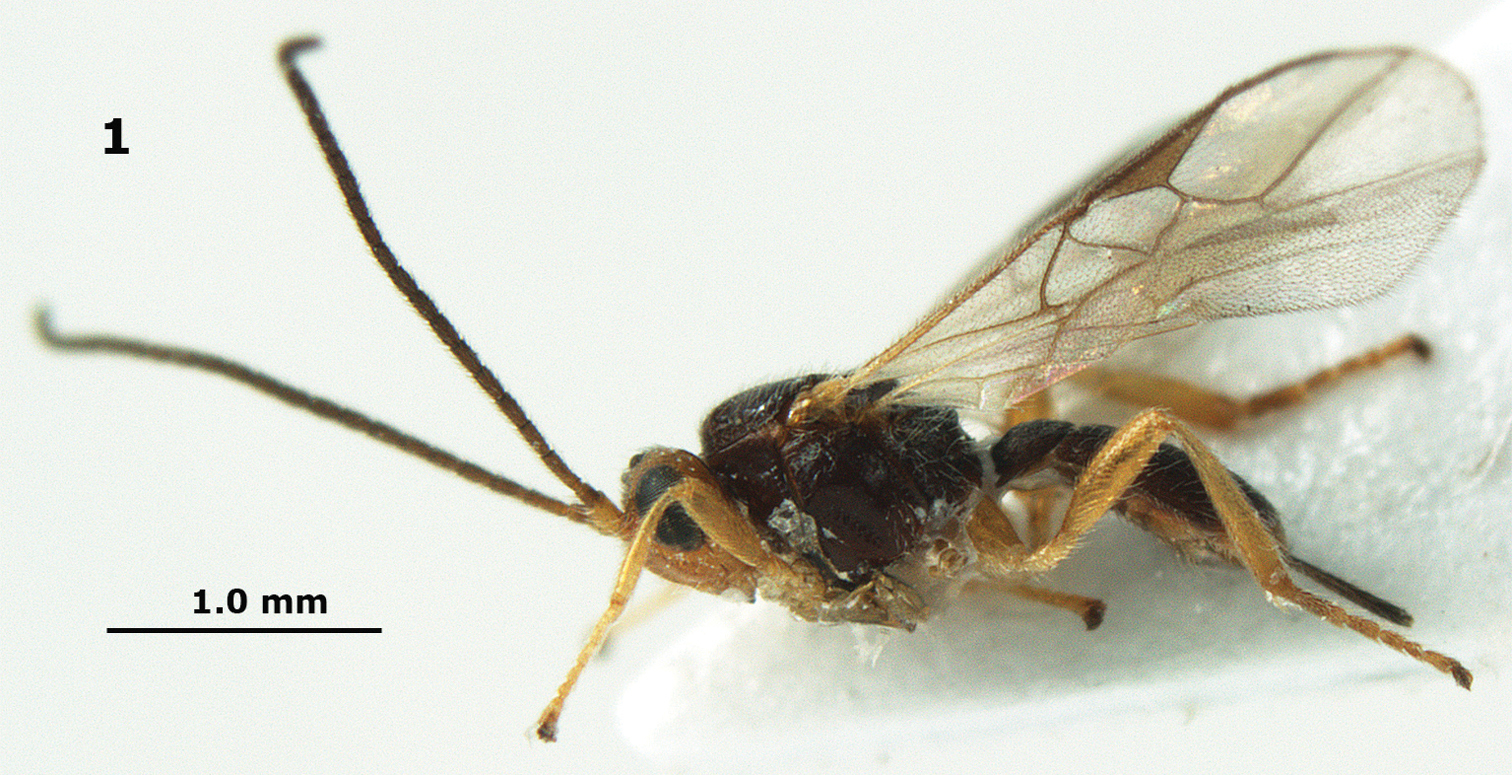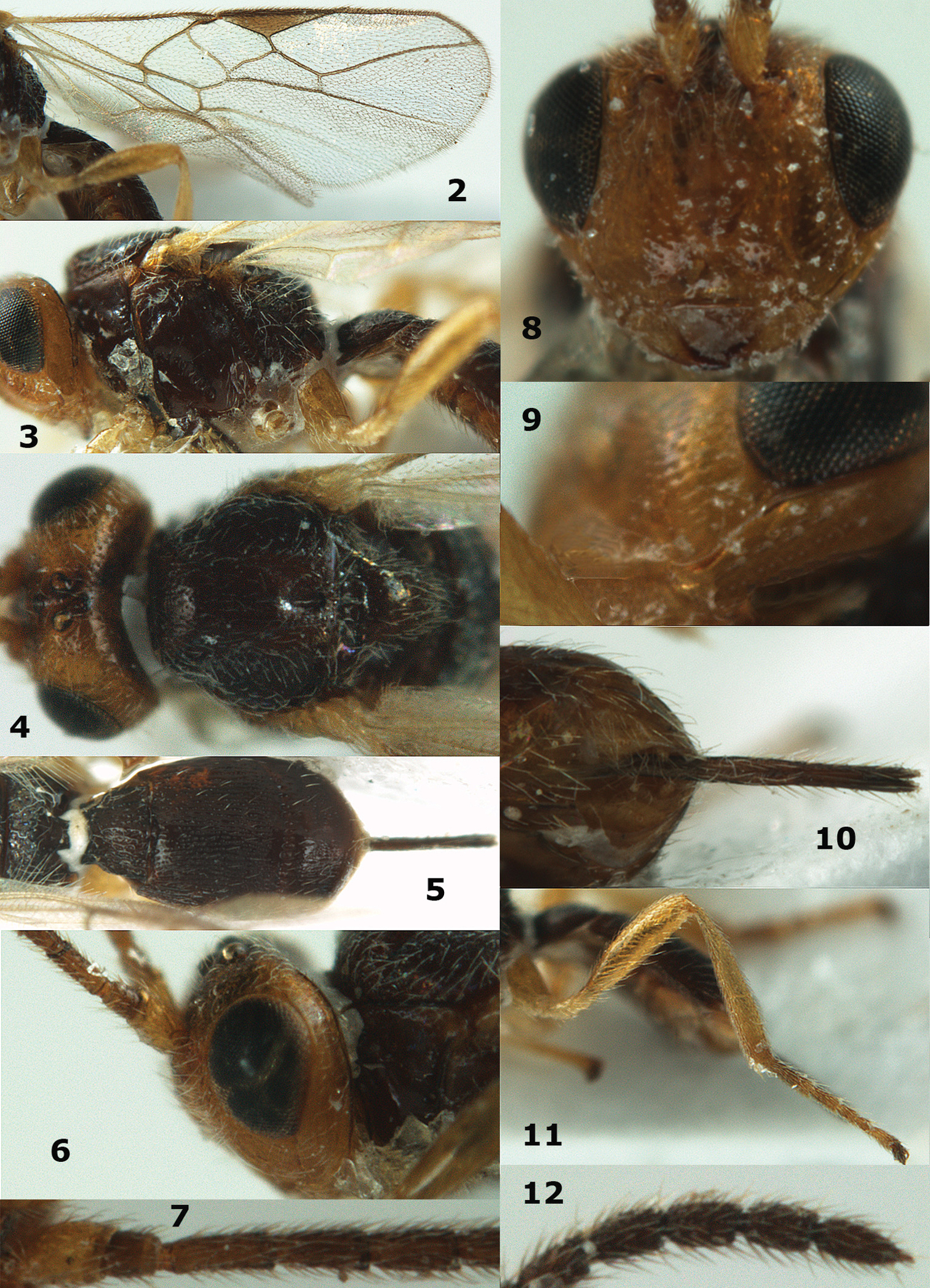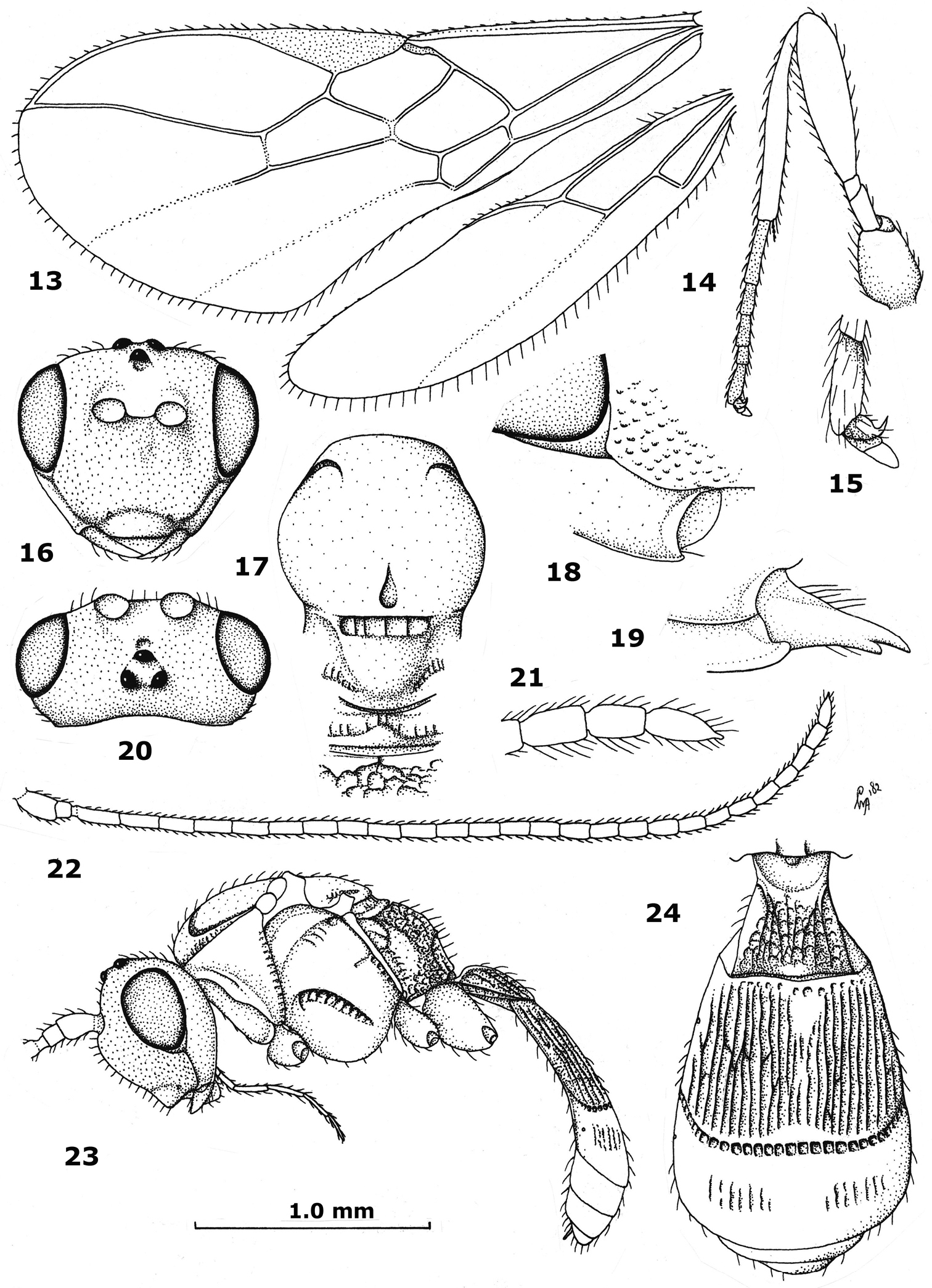






(C) 2012 Cornelis van Achterberg. This is an open access article distributed under the terms of the Creative Commons Attribution License 3.0 (CC-BY), which permits unrestricted use, distribution, and reproduction in any medium, provided the original author and source are credited.
For reference, use of the paginated PDF or printed version of this article is recommended.
The genus Orientopius Fischer, 1966 (Hymenoptera: Braconidae: Opiinae) is reported for the first time from continental China and a new species (Orientopius punctatus sp. n.) is described from Hunan. Orientiopius tambourinus Fischer, 1966, is transferred back to the genus Orientopius. A key to the Indo-Australian species is added.
Braconidae, Opiinae, Orientopius, new species, Oriental, China, Hunan, key
The genus Orientopius Fischer, 1966 (Braconidae: Opiinae) is a small genus with 15 described species from Palaearctic, Oriental and Australian regions. Orientopius is closely related to Coleopius Fischer, 1964 (
Its biology was unknown until recently van
The holotype was found in the collection of Hunan Agriculture University at Changsha and was re-prepared. The holotype is deposited in the Institute of Insect Sciences, Zhejiang University (ZJUH) at Hangzhou. For identification of the subfamily Opiinae, see van
http://species-id.net/wiki/Orientopius
Figures 1–24Orientopius curiosigaster Fischer, 1966 (original designation).
Clypeus truncate medio-ventrally (Figs 8, 16); labrum exposed (Fig. 8); occipital carina present latero-dorsally and weakly or not protruding in lateral view (Figs 6, 23); head comparatively long in anterior view (Figs 8, 16) and malar space longer than basal width of mandible (Figs 9, 18); malar suture present (Figs 9, 16); inner sides of antennal sockets normal, not protruding (Fig. 20); around base of middle coxa no circular carina; medio-posterior depression of mesoscutum present (Figs 4, 17); notauli absent posteriorly (Figs 4, 17) or as row of punctures; postpectal carina variable, usually partly present medio-ventrally; vein 3-SR of fore wing 0.9–2.0 times as long as vein 2-SR (Figs 2, 13); metasoma with carapace (Fig. 1), but less developed in males (Figs 23, 24); second tergite sculptured and distinctly longer than third tergite (Figs 5, 23, 24); dorsal carinae of first tergite variable, separated basally (Fig. 24) or medially united in a median carina (Fig. 5); second metasomal suture distinct (Figs 4, 24); third tergite of female with a sharp lateral crease.
urn:lsid:zoobank.org:act:6368ECFD-581F-41F5-A566-6B03068C1373
http://species-id.net/wiki/Orientopius_punctatus
Figures 1–12Holotype (ZJUH), ♀, “[S. China: Hunan], Nan Mt., meadow, 18.VII.1988, Fu-Xing Li”.
Vein SR1 ends near apex of fore wing (Fig. 13); vertex moderately densely punctate, with interspaces mostly wider than diameter of punctures or wider (Fig. 4); antenna dark brown, except basally; malar space about 1.5 times as long as basal width of mandible and head less elongate in anterior view (Fig. 8); pterostigma dark brown; mesosoma dark brown or blackish (Figs 1, 3, 4); transverse carina of propodeum distinctly in front of middle of propodeum; hind basitarsus about 3.7 times as long as wide (Fig. 11); dorsal carina of first tergite united subbasally; second tergite about twice as long as third tergite and with rows of punctures between striae (Fig. 5); third tergite 0.3 times longer than its basal width; third metasomal tergite semi-circular and partly distinctly punctate (Fig. 5); fourth tergite of female smooth and retracted (Fig. 1); setose part of ovipositor sheath 0.6 times as long as combined first-third metasomal tergites, 0.2 times as long as fore wing and 0.8 times as long as hind tibia (Fig. 1).
Orientopius punctatus sp. n., female, holotype. Habitus lateral.
Orientopius punctatus sp. n., female, holotype. 2 wings 3 mesosoma lateral 4 mesosoma dorsal 5 metasoma dorsal 6 head lateral 7 base of antenna 8 head anterior 9 malar space 10 ovipositor sheath ventral 11 hind leg 12 apex of antenna.
Holotype, ♀, length of body 2.3 mm, of fore wing 2.5 mm.
Head. Antenna with 25 segments and 1.1 times as long as fore wing; third segment 1.1 times as long as fourth segment, length of third, fourth and penultimate segments 2.7, 2.5 and 1.8 times their width, respectively (Figs 7, 12); length of maxillary palp unknown, palp submerged in glue; occipital carina widely removed from hypostomal carina and dorsally absent; hypostomal carina narrow; length of eye in dorsal view 3.3 times temple; temples directly narrowed (Fig. 4) and largely smooth; vertex finely punctate, with interspaces mostly wider than punctures; frons slightly depressed behind antennal sockets and with some curved rugulae, remainder slightly convex and setose, largely finely punctate, with interspaces wider than punctures; face medio-dorsally elevated, coarsely punctate, with interspaces slightly wider than punctures and some striae latero-dorsally; width of clypeus 2.8 times its maximum height and 0.6 times width of face; clypeus flat, smooth and its ventral margin rather thin and medially straight; hypoclypeal depression wide and deep (Fig. 8); labrum flat (including ventral rim); malar suture complete; with punctures between malar suture and clypeus; length of malar space 1.5 times basal width of mandible (Fig. 9); mandible strongly constricted and twisted apically, without distinct ventral carina, second tooth medium-sized.
Mesosoma. Length of mesosoma 1.3 times its height; dorsal pronope absent, pronotum short and nearly vertical anteriorly; pronotal sides smooth but oblique groove anteriorly and posterior groove coarsely crenulate (Fig. 3); epicnemial area with few crenulae dorsally; precoxal sulcus distinctly impressed, but posterior 0.4 absent, and coarsely crenulate (Fig. 3); pleural sulcus distinctly crenulate; mesosternal sulcus and postpectal carina not visible because of glue; metapleuron coarsely reticulate ventrally and dorsally largely smooth (except some punctures); notauli impressed and with few crenulae anteriorly, and largely absent on disk; mesoscutum flattened, with large elliptical medio-posterior depression, setose and punctulate; scutellar sulcus wide and with 3 coarse crenulae (Fig. 4); scutellum rather flat and sparsely punctulate; metanotum with weak median carina; propodeum posteriorly largely smooth, with coarse curved transverse carina in front of middle and anteriorly rugose and with rather short median carina (Fig. 5).
Wings. Fore wing (Fig. 2): pterostigma triangular; 1-R1 ending close to wing apex and 1.3 times as long as pterostigma; r:3-SR:SR1 = 5:16:50; 2-SR:3-SR:r-m = 16:16:5; r slender; 1-M and SR1 slightly curved; m-cu just postfurcal; cu-a slightly postfurcal and 1-CU1 hardly widened; first subdiscal cell closed, CU1b medium-sized and shorter than 3-CU1; M+CU1 sclerotized. Hind wing: M+CU:1-M:1r-m = 25:18:12; cu-a straight; m-cu absent.
Legs. Length of femur, tibia and basitarsus of hind leg 3.8, 7.0 and 3.7 times as long as wide, respectively (Fig. 11); hind femur with long setae and tibia densely rather short setose; third and fourth segments of fore tarsus distinctly longer than wide and about as long as wide, respectively.
Metasoma. Length of first tergite 0.8 times its apical width, its surface smooth in front of united dorsal carinae and coarsely punctate-reticulate behind carinae, convex and no median carina posteriorly (Fig. 5); second suture coarsely crenulate, nearly straight, slightly widened medially and distinctly impressed; second tergite with row of punctures between longitudinal striae; median length of second tergite 2.1 times median length of third tergite; third tergite mainly with rows of punctures, but medially and posteriorly smooth; following tergites smooth and largely retracted below carapace; length of setose part of ovipositor sheath 0.22 times fore wing, 0.6 times first-third tergites combined and 0.8 times longer than hind tibia; hypopygium far retracted, truncate apically and about 0.2 times as long as metasomal carapace.
Colour. Dark brown, including pterostigma, veins and antenna (but scapus yellow); head and mandible yellow, but head medio-dorsally and posteriorly infuscate; ovipositor sheath blackish; wing membrane subhyaline.
Orientopius curiosigaster Fischer, male, holotype. 13 wings 14 hind leg 15 outer hind claw 16 head anterior 17 mesosoma dorsal 18 malar space 19 mandible and ventral part of occipital carina 20 head dorsal 21 apex of antenna 22 antenna 23 habitus lateral 24 metasoma dorsal. 13, 14, 22, 23: scale-line (= 1 x); 15: 5 ×; 16, 17, 20, 24: 1.3 ×; 18, 19, 21: 2.5 ×.
Oriental China (Hunan).
Unknown.
Name “punctatus”, because of the punctate second metasomal tergite.
The species can be separated from the other non-Palaearctic species as follows:
| 1 | Vein SR1 of fore wing about 1.3 times as long as vein 3-SR; third metasomal tergite nearly as long as second tergite; fourth antennal segment of ♀ about twice as long as wide; [ovipositor sheath about as long as first tergite]; East Malaysia | Orientopius malaysiae Fischer, 1996 |
| – | Vein SR1 of fore wing 2.5-3.3 times as long as vein 3-SR; third metasomal tergite distinctly shorter than second tergite; fourth antennal segment of ♀ about 3 times as long as wide (♀ unknown of Orientopius curiosigaster) | 2 |
| 2 | Wing membrane brown; third tergite more or less convex in lateral view; second metasomal suture smooth; metasoma yellowish-brown; [Australian region] | 3 |
| – | Wing membrane subhyaline; third tergite flat in lateral view; second metasomal suture crenulate (but narrowly so in Orientopius priminans and Orientopius marianus); metasoma black or dark brown | 4 |
| 3 | Second metasomal tergite with longitudinal rows of punctures and third tergite largely smooth (except basal punctures); ovipositor sheath in lateral view about 0.8 times as long as second and third tergites combined and in dorsal view about 0.3 times as long as metasoma; Australia (Queensland) | Orientopius tambourinus Fischer, 1966 |
| – | Second tergite with longitudinal striae and third tergite entirely punctulate; ovipositor sheath in lateral view about as long as second and third tergites combined and in dorsal view about 0.5 times as long as metasoma; Papua New Guinea | Orientopius bishopi Fischer, 1996 |
| 4 | Notauli completely impressed and smooth; vein 1r-m of hind wing about as long as vein cu-a; medio-posterior depression of mesoscutum minute; [malar space about as long as basal width of mandible and without malar suture]; East Malaysia | Orientopius priminans Fischer, 1996 |
| – | Notauli largely absent (except anteriorly); vein 1r-m of hind wing 1.5–2.0 times as long as vein cu-a; medio-posterior depression of mesoscutum large droplet-shaped or elliptical, but small in Orientopius marianus | 5 |
| 5 | Vein 3-SR of fore wing about as long as vein 2-SR; malar space about 1.7 times as long as basal width of mandible; mesoscutum punctulate; apical segments of antenna of ♀ (but ♀ unknown of Orientopius curiosigaster) blackish or dark brown as other segments; [medio-posterior depression of mesoscutum large droplet-shaped; crenulate second metasomal suture moderately wide and parallel-sided medially] | 6 |
| – | Vein 3-SR of fore wing 1.6–2.0 times as long as vein 2-SR; malar space about as long as basal width of mandible; mesoscutum smooth; apical segments of antenna of ♀ white or yellow | 7 |
| 6 | Second metasomal tergite without rows of punctures between longitudinal striae and third tergite only with some superficial striae (Fig. 24); mesosoma brownish-yellow; dorsal carina of first tergite remain separated subbasally (Fig. 24); malar space about 1.8 times as long as basal width of mandible and head more elongate in anterior view (Fig. 16); hind basitarsus about 5.0 times as long as wide (Fig. 14); transverse carina of propodeum near middle of propodeum; second tergite about 1.8 times as long as third tergite medially; Philippines | Orientopius curiosigaster Fischer, 1966 |
| – | Second tergite with rows of punctures between longitudinal striae and third tergite partly punctate (Fig. 5); mesosoma dark brown or blackish (Figs 1, 3, 4); dorsal carina of first tergite united subbasally; malar space about 1.5 times as long as basal width of mandible and head less elongate in anterior view (Fig. 8); hind basitarsus about 3.7 times as long as wide (Fig. 11); transverse carina of propodeum distinctly in front of middle of propodeum; second tergite about 2.1 times as long as third tergite medially; Oriental China (Hunan) | Orientopius punctatus sp. n. |
| 7 | Crenulate second metasomal suture strongly widened medially; medio-posterior depression of mesoscutum large droplet-shaped; vein 3-SR of fore wing about 1.6 times as long as vein 2-SR; ovipositor sheath in lateral view about as long as first metasomal tergite and in dorsal view hardly protruding; 5 apical segments of antenna of ♀ yellow; China (Taiwan) | Orientopius formosanus Fischer, 1966 |
| – | Crenulate second metasomal suture narrow and parallel-sided medially; medio-posterior depression of mesoscutum small elliptical; vein 3-SR of fore wing about twice as long as vein 2-SR; ovipositor sheath in lateral view about 1.5 times as long as first metasomal tergite and in dorsal view about as long as second and third tergites combined; 4 apical segments of antenna of ♀ white; Papua New Guinea | Orientopius marianus Fischer, 1990 |
The late Dr H.K. Townes (American Entomological Institute, Gainesville, Florida, USA) kindly loaned the holotype of Orientopius curiosigaster Fischer to the first author. The first author thanks the Uyttenboogaart-Eliasen Stichting for a travel grant to China, the College of Natural Resources & Environment, South China Agricultural University at Guangzhou and the College of Bio-Safety Science & Technology, Hunan Agriculture University at Changsha for the hospitality and the financial support of the visits to China.


